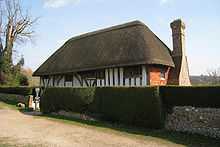Alfriston Clergy House
Coordinates: 50°48′24.5″N 0°9′29″E / 50.806806°N 0.15806°E

Alfriston Clergy House in Alfriston, Polegate, East Sussex, England, was the first property to be acquired by the National Trust. It was purchased in 1896 for £10.[1] The house lies adjacent to the Church of St. Andrew.
History
The house is a 14th-century Wealden hall house. Although the name reflects the fact that the parish priest and his housekeeper used it, the house was originally built as a farmer's house. It is a very modest property — not at all like the grand rectories that many Church of England clergy occupied by the 19th century. It is a low-ceilinged, two-storey, timber-framed building with a thatched roof. Part of the house was rebuilt in the 17th century. It is commonly said that a detail on a cornice wood carving of an oak leaf, may have inspired the National Trust's emblem, but there is no evidence to prove that claim.[2] It has a rare chalk and sour milk floor.[3] Outside there is a small but well-planted cottage garden, which was designed by Graham Stuart Thomas.[4]
The house is open to the public.
References
- ↑ Walker, Marianna (1 June 2008). "50 National Trust hidden gems". The Daily Telegraph. Retrieved 2010-07-07.
- ↑ Knight, Jane (August 1, 2009). "The great British weekend: Cuckmere Valley, East Sussex". The Times. Retrieved 2010-07-07.
- ↑ "Alfriston Clergy House". Sussex Tourism Partnership. Archived from the original on 11 July 2010. Retrieved 2010-07-07.
- ↑ "Graham Thomas". The Daily Telegraph. 19 April 2003. Retrieved 2010-07-07.
External links
| Wikimedia Commons has media related to Alfriston Clergy House. |